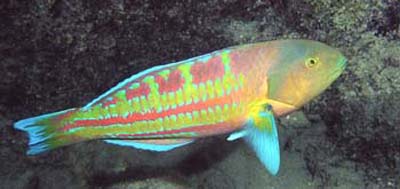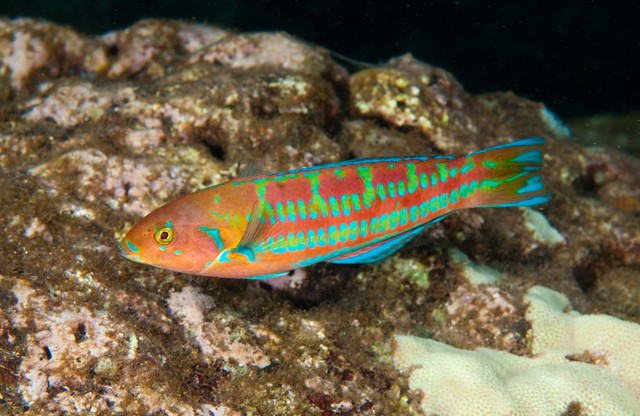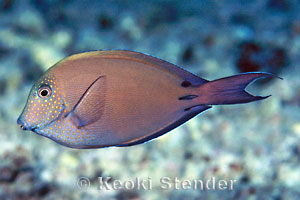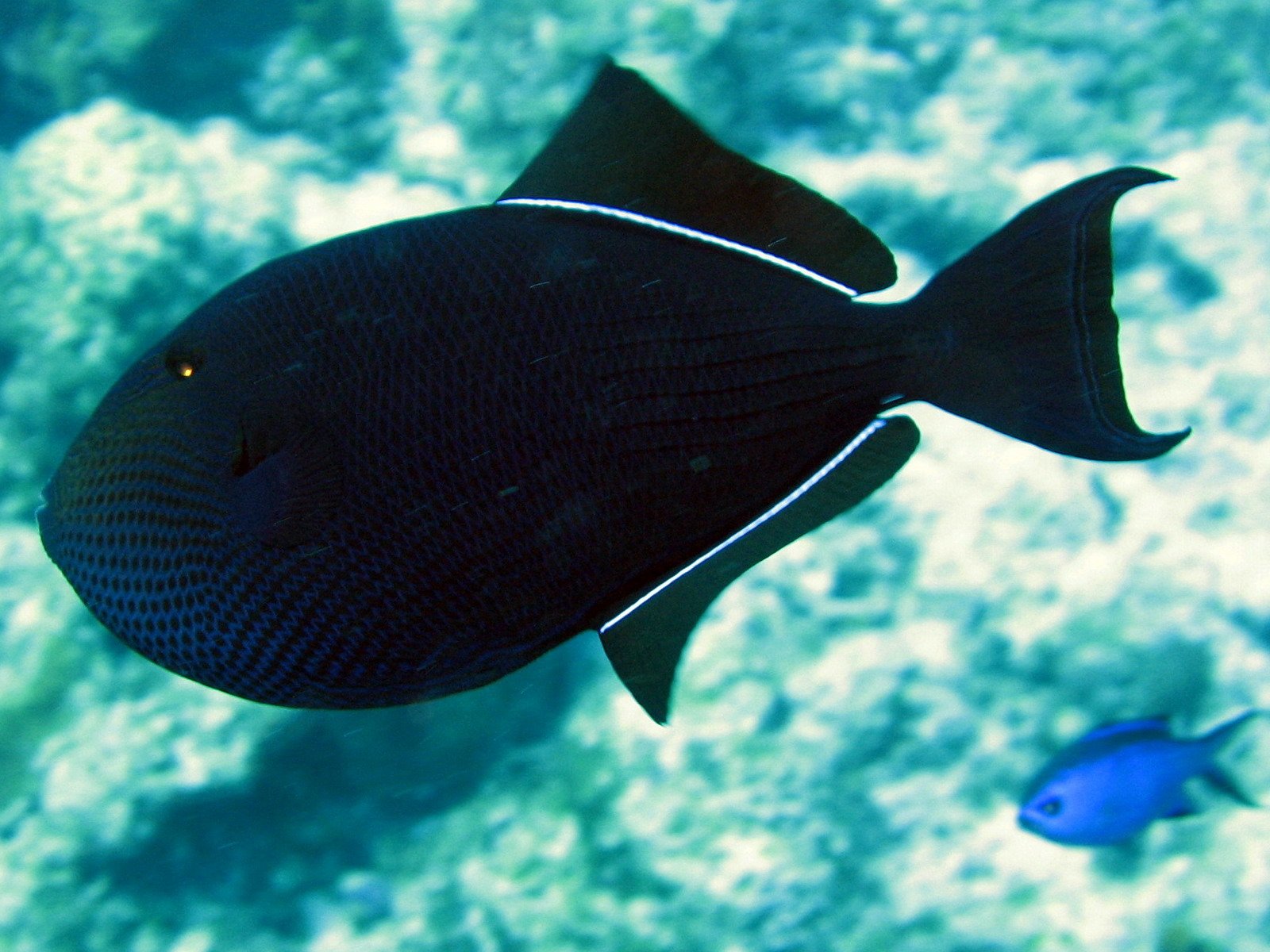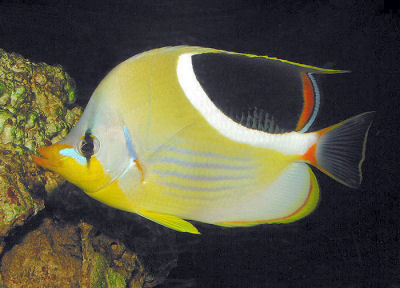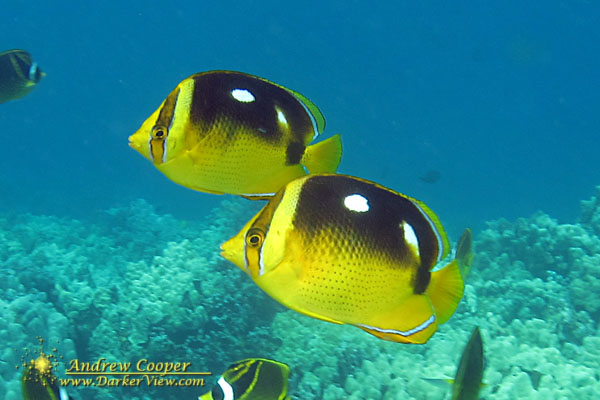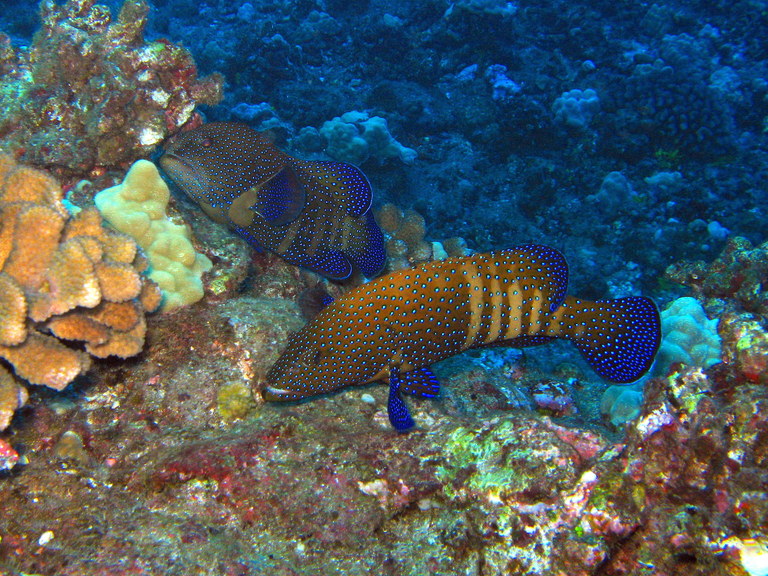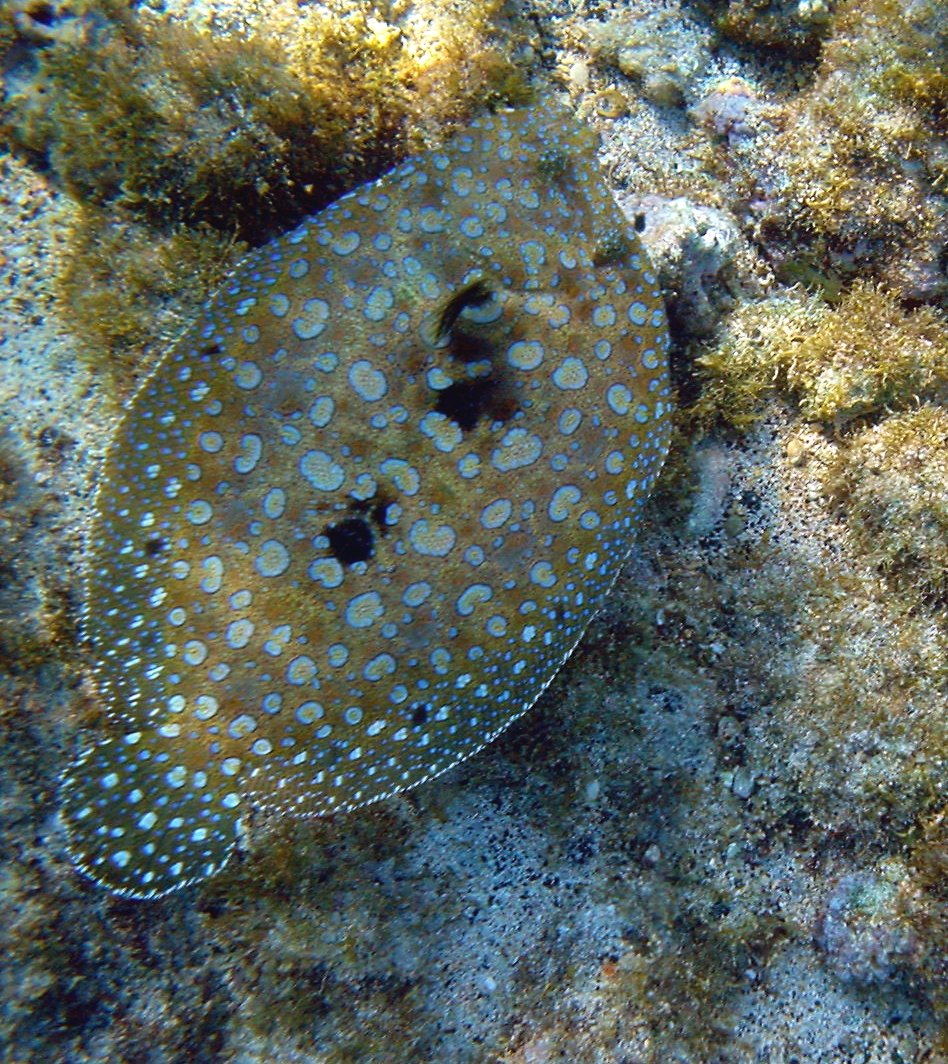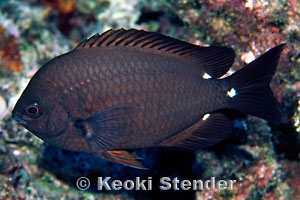 |
Saw this at Captain Cook. This endemic damselfish is usually dark gray or black with three white spots: one above, one below, and one on the base of the tail. It can lighten or darken the spots, which at times almost disappear. Occasionally it turns almost entirely silver gray.
Threespot Chromis typically lighten their bodies while leaving their fins dark, a color pattern resembling that of the Hawaiian Dascyllus.
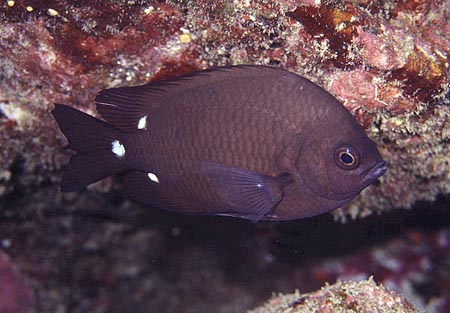 |
Photos (not mine) and descriptions (not mine) of fishes and marine animals seen while snorkeling
Sunday, September 9, 2012
Threespot Chromis
'Awela--Christmas Wrasse
We see many of these beautiful fish at Kahalu'u.
These fast-moving wrasses inhabit shallow reefs, often in the surge zone, where they feed mostly on crabs and molluscs. Terminal males have bright ladderlike blue-green markings on a reddish body. The brown and green initial phase adults (both sexes) are smaller and drab by comparison.
At night these fish sometimes sleep in tide pools just above the water line where they can be discovered by flashlight. Juveniles occur in tide pools.
The female has greenish body with irregular rows of brown spots and stripes.
Kalo--Brown Surgeon Fish
This fish feeds in the shallows close to shore and is so common and unremarkable in color that few pay it any attention. Nonetheless, it is a fascinating animal.
It varies from dark brown to light grayish brown with a definite lavender tinge, especially on the fins. There are dull orange spots on the head and two dark spots at the base of the tail, one above the other. The tail fin is lunate (crescent-shaped). When displaying aggression its upper back and the entire dorsal fin lighten, sometimes becoming distinctly yellow.The species name nigrofuscus means "dark brown." The Hawaiian name refers to a variety of kalo (taro). |
Humuhumu'ele'ele--Black Triggerfish
The black triggerfish is a blimp-shaped with bright white lines running along its doral and anal fins. When in the water, it appears to be completely black. However, if it is taken out and exposed to bright light, one can see that it is actually of a dark-blue/green coloration.

It is a common aquarium fish

It is a common aquarium fish
O'ili--Barred File Fish

One of my favorite fish because he is so cute and odd shaped. Sometimes swims sideways.
Their laterally compressed bodies and rough, sandpapery skin inspired the filefish's common name; it is said that dried filefish skin was once used to finish wooden boats.
Either solitary, in pairs or small groups depending on the species, filefish are not terribly good swimmers; their small fins confine the fish to a sluggish gait. Filefish are often observed drifting head downward amongst stands of seaweed, presumably in an effort to fool both predator and prey alike. When threatened, filefish may retreat into crevices in the reef.

Humuhumu hi'ukole--Pinktail Trigger Fish
 |
Isn't this a beautiful fish!!!
This Triggerfish is named for its "pink tail". The body is so dark it looks black, but in reality it is a very deep forest green color. The dorsal and anal fins have a translucent pinkish-white appearance marked with dark bands at the outside edges, and the pectoral fins have a yellowish color to them.
|

A shy fish.
Kikakapu--Saddleback Butterflyfish
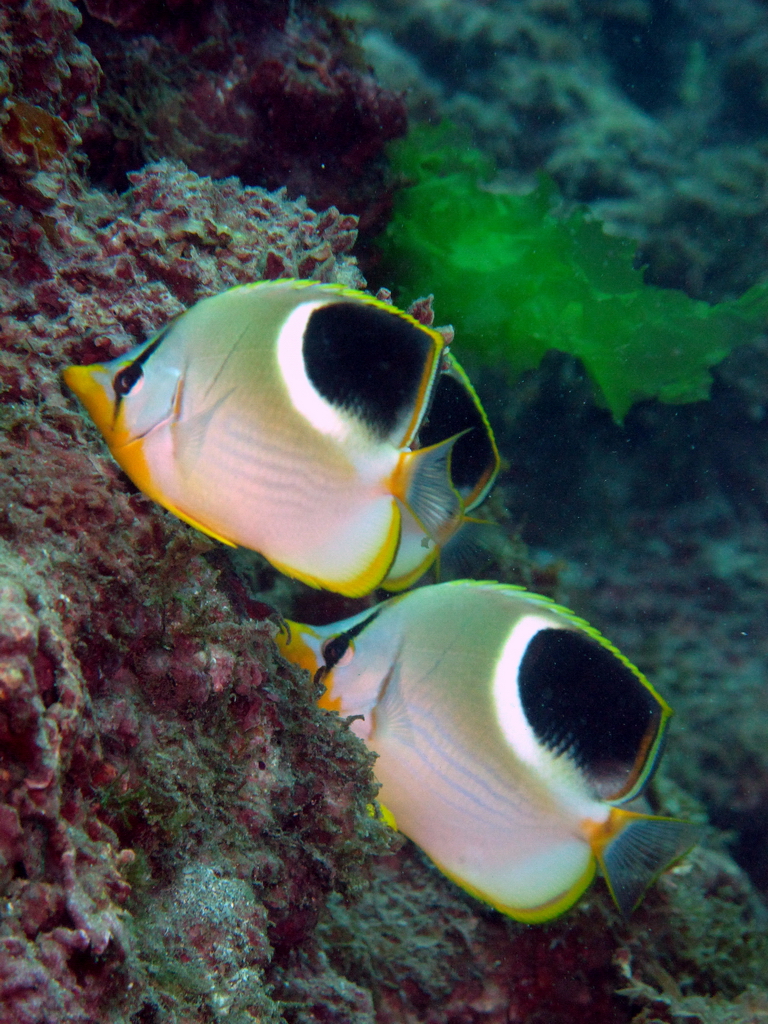 |
I have been looking for these beautiful butterflyfish and just saw them today!!!
Golden snout and chest, larger black part on upper part of body, including dorsal fin, white line around black patch. Also note red markings at base of tail, and blue stripes along side of body.
Relatively uncommon in Hawaii.
|
Lauhau--Four Spot Butterflyfish
| The Fourspot Butterflyfish is a very active, but rather shy species. If startled or frightened this fish will dart around frantically. It is powerful, can jump quite well to avoid getting caught, and caution should be used when handling this fish, as its top dorsal spines can inflict a rather nasty poke. Orange eye bar bordered with black or blue followed by a yellow bar. Two white spots on each side of dark part of upper part of body. Lower body yellow. Easily approachable. |
Ma'oma'o--Hawaiian Sergeant
 |
We saw these at Captain Cook: Five black bars, yellow tint only as juveniles, fades as they grow into a greenish-white. Black marking on anal fin.
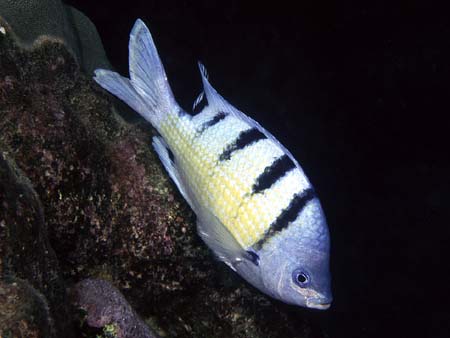
The abdomen often develops subtle yellow striping, the bars can lengthen or shorten, and the ground color can lighten or darken. Juveniles, common in tide pools, are yellowish between the bars.
Hawaiian Sergeants are frequently seen swarming high off the bottom to feed on plankton, usually over a specific area of the reef where they shelter and reproduce. When disturbed they dive as one for cover, but soon rise again to resume feeding. In bright sunlight they will feed almost at the surface; when clouds cover the sun they descend somewhat. In addition to plankton, these fish will consume algae or anything else they can find.
|
Roi--Peacock Grouper
 |
Peacock grouper
◆ Roi are protogynous hermaphrodites, which means they start life as females and later switch sexes to males. ◆ Roi take two years to become sexually reproductive and generally live in harems of 1 male and up to 12 females. ◆ Roi harems occupy fixed territories, which the male defends against intrusion from neighboring harems.
◆ In Hawaii, individuals were found up to 16 years of age in studies, with a depth range of 1 to 130.
◆ On the Kona Coast, the average density of roi is eight individuals per 11,000 square feet.ion
|
Hinalea i'iiwi--Bird Wrasse
The most unique aspect about the Bird Wrasse is its elongated beak which is used to catch long, skinny prey and hold it captive while breaking it up into bite-size pieces.
The female is brownish black, and the male is variations of green. For this reason the male is often called the Green Bird Wrasse, and the female,
Lau-wiliwili-nukunuku-'oi'oi--Long-nosed Butterfly Fish
One of the most beautiful fishes. We see these when we snorkel at Captain Cook and Two Step.
Yellow body, long snout and black spot on anal fin. Uses their extended snout to reach deep into crevices and coral to catch their prey.
Yesterday, Rich saw an all black one. It is a phase which is seen along the Kona coast, but is rare elsewhere. Black Longnose Butterflyfish when placed into aquariums will revert back to their more common yellow phase.
Yellow body, long snout and black spot on anal fin. Uses their extended snout to reach deep into crevices and coral to catch their prey.
Yesterday, Rich saw an all black one. It is a phase which is seen along the Kona coast, but is rare elsewhere. Black Longnose Butterflyfish when placed into aquariums will revert back to their more common yellow phase.
Saw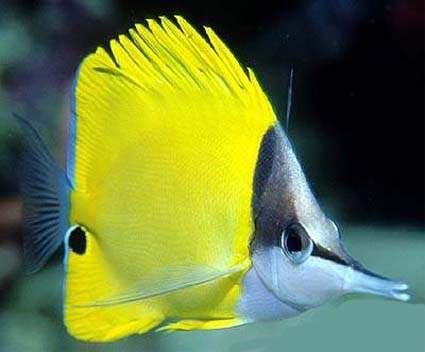

Kole--Goldring or Yellow Eyed Surgeonfish
Saw these beautiful fish at Captain Cook
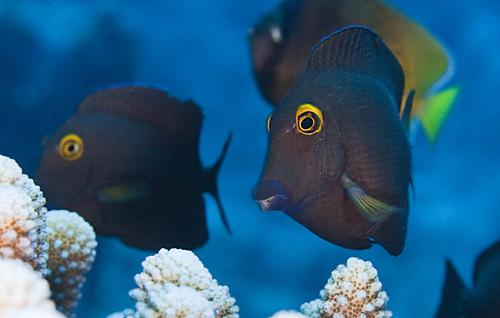
This dark colored surgeonfish is distinguishable by its fine, horizontal striping, yellow eye-ring and blue lips. It is endemic (that is unique) to the Hawaiian Islands and Johnston Atoll.
Goldring are diurnal herbivores that browse on filamentous seaweeds and diatoms covering the seafloor. Their mouths have bristle-like teeth giving rise to one of their groups’ common names––“bristletooths”
Goldring bristletooths are one of the two most common species seen at turtle cleaning stations where they browse on the algae and diatoms coating the turtle’s carapace. Goldrings appear to prefer the algae growing on the hard parts of turtle’s bodies, while closely associated yellow tang prefer algae from the soft parts. The behavior of these respective species is indicative of one way that closely related species specialize, thereby avoiding competition for similar resources.
Interestingly, while browsing on turtles, Goldring bristletooths will tolerate the presence of divers much closer than while feeding in schools or on their own.

Monday, September 3, 2012
Pak'ii--Hawaiian Flounder
Our first time at Kahalu'u Beach Park this visit and we saw Pak'ii, the Hawaiian Flounder. The fish is regal, graceful, and beautifully camouflaged. The photos underwater photos are not mine, but borrowed from the web.
underwater video of flounder swimming
Flat as a pancake and oval or rounded in shape, this fish spends much of its time buried to its eyeballs in sand or gravel. When it does move about, fluttering silently across the ocean floor, it can change its coloring and skin pattern to perfectly match its surroundings.
The flowery flounder's base color is pale brown, almost yellow. It has both brownish spots and flowery-looking blue spots reminiscent of a peacock's finery.
The eyes of the mature flowery flounder sit on two protuberances located on the left side of the body above the fish's mouth. The eyes move independently and can look in two different directions at the same time. The eyes of males typically are set further apart than the eyes of females.
The unique left-side placement of the eyes gives this fish a lopsided appearance. The location makes sense, however, considering that due to its habit of lying slightly on its right side buried in sand, the fish would have one eye submerged in grit most of the time if the eyes were evenly placed.
In the manner of all flatfishes, flowery flounders begin life perfectly symmetrical - their eyes evenly placed one on each side of their heads. Early on, they swim upright. While the flounder is still in the larval stage, one of its eyes begins migrating to the opposite side of its head to join the eye there. The fish also starts turning on its side while swimming or burying itself in the sand. Eventually, when the fish is buried, both its eyes protrude to take in the surroundings and watch for prey. Safely hidden from predators, the young flounder can then ambush small unsuspecting fish or crustaceans.
All flatfishes are carnivorous, preying on smaller fish and other ocean creatures such as shrimps and crabs. All have patterned topsides and generally white or light-colored undersides. Some can produce toxins. Many are rated good food fish.
underwater video of flounder swimming
Flat as a pancake and oval or rounded in shape, this fish spends much of its time buried to its eyeballs in sand or gravel. When it does move about, fluttering silently across the ocean floor, it can change its coloring and skin pattern to perfectly match its surroundings.
The flowery flounder's base color is pale brown, almost yellow. It has both brownish spots and flowery-looking blue spots reminiscent of a peacock's finery.
The eyes of the mature flowery flounder sit on two protuberances located on the left side of the body above the fish's mouth. The eyes move independently and can look in two different directions at the same time. The eyes of males typically are set further apart than the eyes of females.
The unique left-side placement of the eyes gives this fish a lopsided appearance. The location makes sense, however, considering that due to its habit of lying slightly on its right side buried in sand, the fish would have one eye submerged in grit most of the time if the eyes were evenly placed.
In the manner of all flatfishes, flowery flounders begin life perfectly symmetrical - their eyes evenly placed one on each side of their heads. Early on, they swim upright. While the flounder is still in the larval stage, one of its eyes begins migrating to the opposite side of its head to join the eye there. The fish also starts turning on its side while swimming or burying itself in the sand. Eventually, when the fish is buried, both its eyes protrude to take in the surroundings and watch for prey. Safely hidden from predators, the young flounder can then ambush small unsuspecting fish or crustaceans.
All flatfishes are carnivorous, preying on smaller fish and other ocean creatures such as shrimps and crabs. All have patterned topsides and generally white or light-colored undersides. Some can produce toxins. Many are rated good food fish.
Subscribe to:
Posts (Atom)
